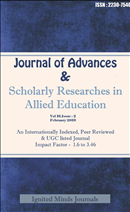Comparative Study of Self-Concept between Ancient and Modern Martial Art Players
Examining the Impact of Ancient and Modern Martial Arts on Self-Concept
Keywords:
comparative study, self-concept, ancient martial arts, modern martial arts, junior karate-do players, junior kalaripayattu participants, uttar pradesh, kerala, percussive and non-percussive martial arts, random sampling techniqueAbstract
The study purpose of the study was to compare the extent of Self-Concept between junior Modern martial arts players (Junior Karate¬-do players) and Ancient Martial Arts Players (Junior Kalaripayattu participants) of Uttar Pradesh and Kerala respectively. Martial Art is a common type of fighting skills. The origin of martial art is difficult to trace. There are several types of martial arts in this world prevailing, i.e., percussive and non-percussive. Karate-do represents a method of unarmed self- defense based on the rational use of all body parts. The Subjects were selected randomly using Random sampling technique. Players selected from both states were divided in two groups Karate-do Group (N=100) and Kalaripayauttu Group (N=100). Self-Concept Questionnaire was administered, which included 48 test items in 8 separate dimensions of Self Concept. The subjects age range was from 14-18 years. Result of the study indicates that statistically significant difference in self-concept was observed between Ancient Martial Arts and Modern Martial Arts Players.Published
2019-02-01
How to Cite
[1]
“Comparative Study of Self-Concept between Ancient and Modern Martial Art Players: Examining the Impact of Ancient and Modern Martial Arts on Self-Concept”, JASRAE, vol. 16, no. 2, pp. 1523–1525, Feb. 2019, Accessed: Dec. 26, 2025. [Online]. Available: https://ignited.in/index.php/jasrae/article/view/10361
Issue
Section
Articles
How to Cite
[1]
“Comparative Study of Self-Concept between Ancient and Modern Martial Art Players: Examining the Impact of Ancient and Modern Martial Arts on Self-Concept”, JASRAE, vol. 16, no. 2, pp. 1523–1525, Feb. 2019, Accessed: Dec. 26, 2025. [Online]. Available: https://ignited.in/index.php/jasrae/article/view/10361











